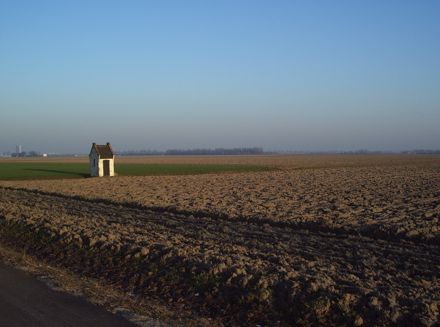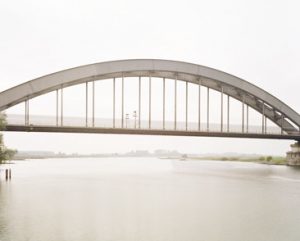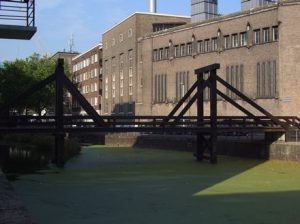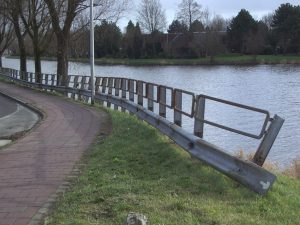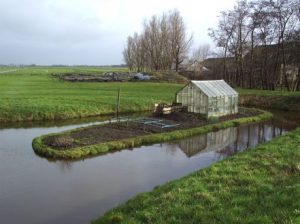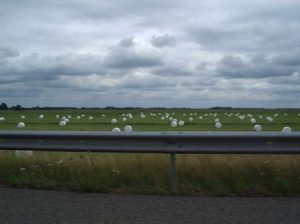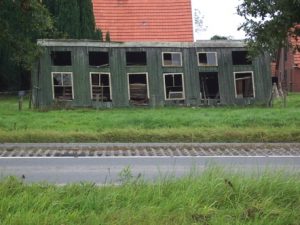This year the Green Heart Cycle Race took place for the second time. Cyclists might think a course of 204.6 kilometres with no cobbles and no mountains is not particularly interesting, but cycling was not Maarten Kloos’ main objective when he launched the initiative for setting up this race. ‘I had a feeling that things would start to go awry with the spatial planning in the western part of the Netherlands if there was no good plan for the Green Heart. When I watched the television reports on the Tour de France and the Giro d’Italia, I not only enjoyed the cycling but also the beautiful countryside they were cycling through.’ Kloos wanted a lengthy video shot like this of the Green Heart and this year 218 thousand people were able to enjoy this five-hour broadcast with breathtaking helicopter pictures of green polders, winding ditches, sparkling lakes with here and there an isolated farm – and the echelons of cyclists weaving their way through it all.
A single ‘Dutch’ landscape does not exist – compare the pictures of the Amstel Gold Race through the hills of Limburg with those of the Green Heart. Neither does a single ‘European’ landscape: you only need to follow the international cycle train for a few days to see this. Yet there are common characteristics, despite the enormous differences in landscape. Untamed nature is rare in Europe, and the effect of human interference is never far away. Centuries of human management of nature have led to a consistency in cultivation and civilisation and a layered and complex landscape – in short, to an accommodating landscape.
In the same way that the American landscape is bound up with the automobile and the road movie, so its scale and multiformity makes the European landscape one inspired by cyclists and more suited to them. If it isn’t from feeling the pedals under your feet, then it is from watching it flash past in the splendid recordings of the cycle tours. The names themselves can be sufficient to summon the landscapes: Vuelta a Castilla y Leon, Giro del Piemonte, and the Hel van Mergelland.
Pastoral
The European landscape has been shaped by centuries of agrarian tradition, from the cultivation of grapes on carefully structured terraces to sheep farming which has given us heath land, from arable farming in plots opened up in forests to wild boar whose rooting keeps the clearings open in a park-like landscape among the oak trees. Thinking of Europe conjures up images of fields, wooded banks and stone walls, of meadows, thickets and scattered villages submerged among them.
We cannot help but think of this pastoral vision when we talk about Europe – they are the landscapes where we like to spend our holidays. Yet such landscapes do not predominate in the exhibition called A wider view – Culture Landscapes in Europe, which will take place from 11 June to 27 September during the International Triennial in Apeldoorn. Agrarian landscapes make up roughly one third of the examples which represent the European landscape. These are the landscapes which are subject to the greatest pressure because their economic support – traditional methods of agriculture – is disappearing.
The creeping process of decline has adopted various forms: the land has been left untilled in some areas, while in others the efficiency of production has been increased through scale increases: the land has suffered from erosion in some places, while in others it has been allowed to flourish and run wild; some areas have been depopulated while others have seen an influx of new inhabitants: some regions have been designated ‘natural area’ while others have seen a change to monoculture. But the fact that the decline has been economic means that protection of the landscape is an extremely complex question.
A wider view envisions two strategies to combat the degeneration of these landscapes: top down using a ‘management strategy’ or bottom up by reinforcing local communities and indirectly revitalising landscapes.
Model railways
The management approach takes the desired landscape as its starting point. A good example of this is the Hungarian puszta near Hortobágy, where bulldozers have closed up the irrigation systems dating from the 1950s in order to restore the agricultural land to the dry steppe inhabited only by wild horses and birds which had existed previously. This nature reserve will receive economic support from tourists, attracted by the traditional puszta, a landscape which is incidentally not all that old: it only came into being in the nineteenth century when the canalisation of the River Tisza led to its unintentional drying up.
The management strategy is often closely linked to tourism: Tuscany also relies on tourism for the protection of its landscape of vineyards, avenues of cypresses, of cornfields and small hilltop-villages.
The region is so famous and has such economic strength that it is, in fact, more like a brand which is being maintained.
The fact that this may also undermine its vitality can be seen in the perfectly restored medieval villages with no advertising hoardings to be seen anywhere but rather a surplus of roll-down shutters instead. This is where wealthy townspeople re-enact the Italy of yesteryear from time to time. The result is wonderful but has a deathly quality: the local population can hardly afford the houses there.
The most extreme example of the tourism-first approach to managing the landscape is the Kulturlandschaft Albula-Bernina in Switzerland, where the history of tourism is itself protected in the shape of the Rhaetian Railway. At the beginning of the last century, two railways were built straight through the mountain landscape as a tourist attraction, with tunnels and giant bridges resembling Roman aqueducts. This summer, Unesco will decide whether the Rhaetian Railway will be given a place on the World Heritage List, following other sites like Hortobágy’s puszta and Tuscany’s Val d’Orcia. This would provide powerful protection not only for the railways themselves but also for the panoramas to be enjoyed from the train windows, meaning that nothing could impinge on the idyll of this magnificent full-scale model railway.
The second strategy to managing landscapes uses society as a driving force. It is noticeable that architects are among the primary advocates of this strategy. The objective is not so much protection of the entire landscape but the preservation and revitalisation of the architectural heritage. How do you apply traditional building methods and how do you place buildings selectively and carefully in the landscape?
The creation of local employment opportunities is essential in order to prevent young people from moving out of the area.
The Italian region of Cinque Terre deliberately focuses on strengthening agriculture in order to preserve the character of the landscape. Without farmers the terraces, with their hand-stacked walls, would stand no chance of surviving. Initially, only the vineyards were involved, but after the pilot phase the farmers were also given help with their olive and citrus farms and even a completely new crop was even introduced: basil. Here, unlike Tuscany time has not been frozen.
Red books
It is no simple task to halt the decline of traditional agricultural landscapes. Landscapes which have developed over the course of centuries, or even of millennia, can decay in the course of a few short decades.
And sometimes this process is accelerated when a region makes a radical switch to a different agricultural product due to European subsidies, or when the diversity of certain crops is replaced by a monoculture. The increases in scale continue, and in addition to this, there is the European requirement that ten percent of transport must run on bio-fuels by 2020. This alone will require an area of 25 million hectares of agricultural land, almost half of the surface area of France.
Two years ago the Canadian geographer Robert Zimmerman warned once more of the rapid decline in the European landscape in his study Environmental Science & Policy. He finds it incomprehensible that there are coffee table books on almost every aspect of the European natural and cultural habitat, but that there is not a single illustrated guide to the rural appearance of Europe. So he set out to write a Red Book for the European landscape himself. The title revives the idea of the guides published by the famous English landscape designer Humphry Repton at the end of the eighteenth century.
During his journeys through Europe, Zimmerman was unable to trace some of the landscapes. Nowhere in south-western Germany was he able to find any traces of Charlemagne’s three-field system – one year of wheat or rye, one year of barley or oats, one year fallow – nowhere a system which introduced such a radical change into European agriculture. Coltura promiscua – a traditional form of agriculture with alternating rows of vines and olive trees with winter wheat in between – also seemed to have disappeared. He still found the combined cultivation of grapes, olives and cattle feed at scattered locations in Tuscany, Umbria and Marche.
Zimmerman does not wish to indulge in nostalgia about this loss; he knows that the beauty of these landscapes was accompanied by poverty. But you can feel his joy when he finds a landscape which looks almost the same as that of a painting from 1443 on the French bank of Lake Geneva. Without ever naming it explicitly, Zimmerman manages to evoke the image of landscapes which are becoming extinct, like some animal species and languages, and he thinks the least we can do is create an inventory by which to record them.
Eric Luisten, curator of the A wider view exhibition and professor of Cultural History and Design at the Technical University of Delft, is also surprised that there is no overview of culture landscapes. ‘There are established European networks for ecology, for architecture, for cultural history and for town and country planning, but for landscape architecture it is still in its infancy. The stakeholders who have befriended landscapes appear to differ in each case. ‘I sometimes feel like Noddy looking for the European landscape.’ Initially, Luiten wanted to link a design competition to the exhibition, but he is now pleased to have been able to create an inventory over the entire multi-disciplinary spectrum. He now says, it is very much the question whether an assignment has been reserved at all for landscape architects in classic agrarian landscapes.
War
The role of landscape architecture is simpler in the remaining four categories which A wider view has distinguished: the military landscape, the industrial landscape, land reclamation and the park. Although the role of aesthetics has played a negligible role with the exception of the parks, the hand of the designer has been apparent here from the very beginning. This makes it logical to appeal to landscape architects for protection, renovation or regeneration. Military landscapes are the opposite of rural landscapes; they show a different side of Europe and tell a story of war and division. The large expanses that some cover is noticeable: the Roman Limes, marking the boundary of the empire, run from Scotland to the Black Sea and the communist Iron Curtain from the North Cape to Greece.
These lines together form a cross right across Europe.
They are the product of world empires which have disappeared, and although Europe may be united once again in the EU, there is no cross-frontier approach to these superstructures. There is not even agreement concerning the content on how to approach the Limes. On the Anglo-Scottish border, where the Roman Wall is still largely intact, all efforts are focused on careful restoration. The German section has more or less disappeared, and in Southern Germany, in particular, forts and watchtowers are being rebuilt in order to bring history to life once more. And in the Netherlands where the remains are now buried deep in the soil, the former Imperial border is submerged under reports, studies and working groups.
Remarkably, there is more agreement on the line which dissected Europe not so long ago: the Iron Curtain is to become Europe’s green belt, an Ecological Main Structure 8,500 kilometres long. The strength of the European Green Belt lies in its simplicity: a dead strip is being turned into a life line. However, this is not only a historical line, but it is physically tangible and the biodiversity along its length can be monitored. And finally it is a way of keeping the memory of Europe’s one-time dichotomy alive in the long term.
Lunar landscape
There are two radically different approaches to a landscape: strict preservation and completely new construction. Usually the truth is to be found somewhere in the middle and moderate adaptation is preferred strategy, but in industrial landscapes you encounter these extremes in their unadulterated form. This is no surprise. Of all landscapes, these have been shaped most by human hands, and so the role of large-scale interventions is large in mapping out the future.
Strict conservation is, for example, the approach chosen for the Sečovlje Saltpans. This area, used for salt extraction on the Slovenian coast, dates back to the fourteenth century and the traditional individual exploitation of salt pounds only came to an abrupt end in 1967. The houses where the workers lived – in the summer they had to stay close to the salt pans day and night – were left derelict and are now in a state of collapse. A renovation plan is now needed to save this unique landscape of low dykes and tiny houses.
At the other end of the spectrum – in scale and area – are the brown coal mines in former East Germany. The word ‘gigantic’ does not do justice to bucket wheel excavators which can process more than 200,000 cubic metres of brown coal a day. The grooves which they make through the landscape are many kilometres wide and entire villages can be swallowed in them.
It is almost impossible to repair the lunar landscape that is left once the caravan has passed. The Lausitz region benefits from essential new construction in order to create a landscape for recreation, one where the lakes are shaped irregularly in order to create the maximum shore length for recreation. It is a pity, however, that the planner’s interventions have wiped away as much as possible. Their aim has been to create a landscape which is as natural as possible – as if nothing had happened. However, one might expect that the shifting of such unbelievable amounts of earth that occurred here could have justified some kind of dramatically artificial shape.
A separate category is formed by the industrial landscapes which have been given a new lease of life by the current rise in the price of raw materials, having previously been left idle. Here it is not a matter of the dilemma between preservation and renovation, but the fight between the local population and the international developers. In the Romanian Rosia Montana the Canadian mining firm Gabriel Resources now wants to resume the gold extraction which has been taking place here since time immemorial. The planned opencast mining will mean the end of five mountains, ten churches, twelve cemeteries and 958 farms.
Apart from the loss of cultural heritage, the campaigners are concerned about damage to the environment through the use of cyanide. They can still remember the disaster in the gold mine at Baia Mare to the north in 2000, which poisoned the fish of the Danube on a large scale. Although a large part of the village has already been bought up and the mining company has invested almost 200 million dollars, the opposition is as yet still strong enough for the developers’ mining permits to be put on hold.
[einde kader?]
Removing polders
Clearly, human intervention is also a particularly visible factor in land-water reclamation, and we can expect to see the contribution of landscape architects in such landscapes. Moreover, this category has predominantly North-western European characteristics; it is no coincidence that the example projects are drawn from the Netherlands, Belgium and Denmark. And their ‘origin’ helps, because in this part of Europe the recognition of landscape architecture as a discipline is much further advanced than in Southern or Eastern Europe, and furthermore the government has been playing a role as landscape planner for longer. On the other hand, the economic dynamics are greater here and spatial constraints are tight. This has led to complex compensation plans such as those for the harbour in Antwerp: in order to construct the Deurganck Dock, the harbour company had to invest in eleven natural areas. The Paardenschor has been restored into a breeding and feeding area for birds. Like the industrial areas, we can often see contradictory strategies in land reclamation areas. Take the two Dutch examples: the Beemster and Wieringermeer. A bottom-up approach was chosen for the early seventeenth century Beemsterpolder. Placing the area on Unesco’s World Heritage List led to questions and opposition among the residents of the polder as well as pride. Can we still renovate our farm? And keep horses? Can the ditches be filled in? Can new country houses be built?
Hans Venhuizen of the bureau for culture and spatial planning thought up the ‘Des Beemsters’ brand as a way of addressing these worries about the spatial and economic dynamism of the region. Not only did he draw up a historical and landscape analysis but he also approached residents, farmers, historians and nature conservationists to think about how something can be done in the ‘Beemster’ way. In this way Venhuizen set in motion a cultural transformation which would not have been possible with a purely formal review or an intervention which ‘does no damage to the quality of the Beemster environment as world heritage site, or something like that.’
In total, nineteen projects were discussed in the Beemster in total; agreement was not always reached. One of the projects that have been reserved for the future is energy provision: without energy the polder will be submerged, but is this energy to be generated? According to some, large wind turbines must be built in the polder; they see them as the descendants of the old windmills. Opponents, however, want to protect the polder from modern contamination. At the end of June, students from the summer school attached to A wider view will tackle the Beemster. Perhaps they will come up with plans which can resolve this contradiction. Whereas in the Beemster discussion is actively encouraged, the planners in the Wieringerrandmeer were caught off their guard by disputes in their area. An eight-kilometre long lake is envisaged to separate the former island of Wieringen from the polders built in the thirties, and from the mainland. Half of the sixteen hundred hectares will become water; a quarter will be left to nature and a quarter will be for housing and infrastructure. The planned 2100 houses, for which salt marshes and woods will be created, is to provide funding for the construction of a large-scale recreational area, which should create employment for declining North Holland. Wieringerrandmeer fits in with a series of leisure landscapes in the Dutch countryside and has a number of opponents. These opponents were initially very spirited but most have faded away in the course of the years through consultation, changes and weariness. Last March the provincial government gave the final go-ahead for the project. The thirty farmers who will have to move will be more than adequately compensated: recreation is more profitable than agriculture.
Renovation
The approach to the last category – the parks – was relatively simple.
They have been created by landscape architects have made them, and it is up to landscape architects to maintain and possibly adapt them. But it seems that things are not so simple in Eastern Europe where there is very little recognition in this professional area, as shown by the cry for help from two landscape architects, who are working on the renovation of the park in Sarajevo.
The park was laid out at the end of the nineteenth century. The central axis of three and a half kilometres is flanked by eleven hundred plane trees and seven hundred wild nut trees. It leads from the city to the sources of the river Bosna. The park was very badly damaged during the war and since then has declined even further. Rubbish is still dumped here despite its designation as a water-collection area.
The landscape’s architectonic qualities may not be as great as the famous German Gartenreich or of the Spanish Aranjuez – which are both part of the exhibition and are on the World Heritage List – but the psychological significance of restoration of this park is difficult to overestimate.
Time machine
Europe has expressed its culture in physical terms in the shape of its landscapes.
Zimmerman comments further that the great significance is not so much in the aesthetic value of these landscapes but in the witness that they give to the centuries of hard work and survival. Since we can only experience a landscape once we have moved through it, he has not opted for aerial images but for an exploration on foot. This double physical aspect of the landscape is diametrically opposed to the literal ‘superficial’ acquaintance which Google Earth provides us with – the landscape as a picture which we can zoom in on at will.
The historically developed, physical aspect of the landscape is what makes its protection so complicated. It is not a picture that we can hang up in a museum to keep for future generations. Landscapes live and inevitably change; they are by-products of economic processes. And if we want to stop the time machine, which period are we going to favour? Who is going to determine this? And who holds the purse strings?
As already stated, the exhibition of A wider view is primarily an inventory of the European cultural landscape. It is not comprehensive by any means but it is more important to ask which responsibilities and pretexts are available to landscape architecture. Is the discipline capable of substantiating the splendid intentions which the Landscape Convention of the Council of Europe has set out? This Convention recognises landscapes ‘as an essential part of the environment of man, as an expression of the diversity of their joint cultural and natural heritage, and as the foundation of their identity.’
At the conference in honour of the Dutch ratification of the convention in 2005, Dirk Sijmons, Government advisor for the Landscape said: the concept of ‘landscape’ does not appear in the policy of the European Union. And there is also a great difference between the rules and subsidies of the EU and the guiding, moral summons of the Council of Europe.’ In the conservation and transformation of landscapes, landscape architecture will be irrevocably caught at the point where culture, aesthetics and morality collide with the rigid laws of economy and agricultural politics on the other.

